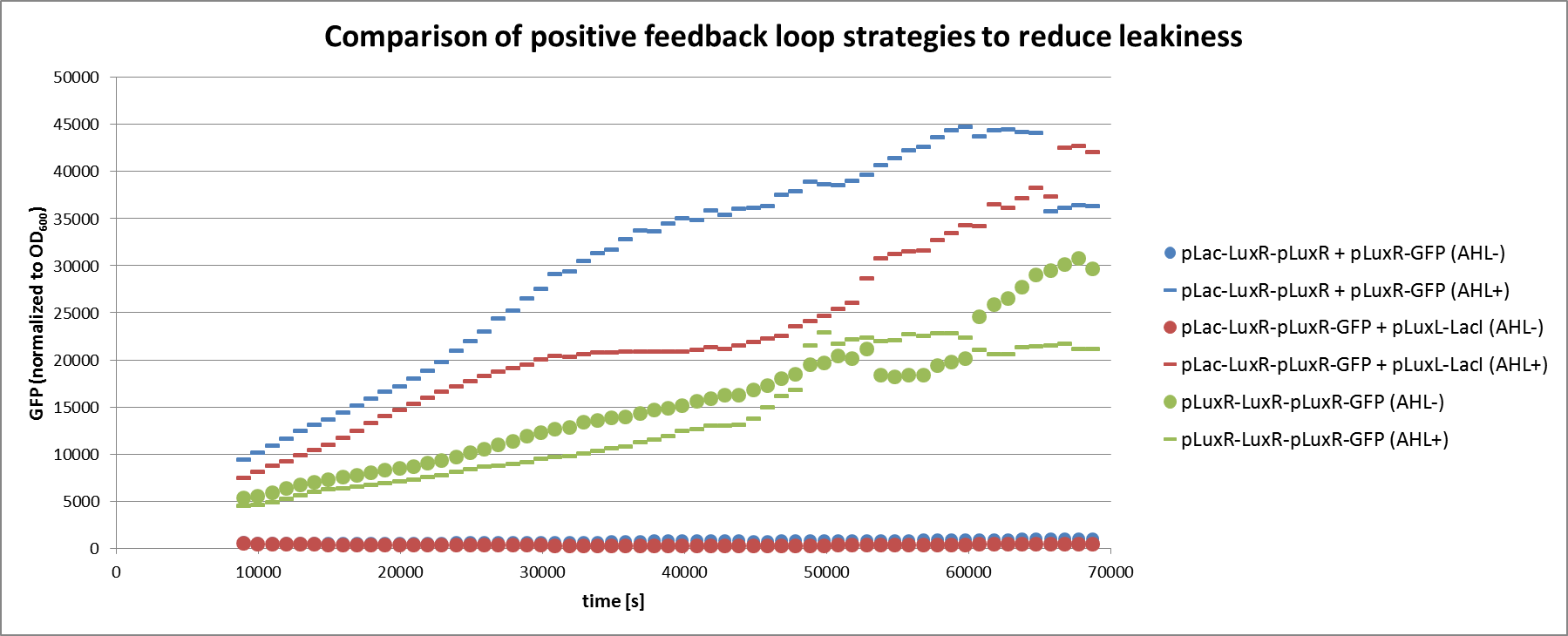Team:ETH Zurich/Optimization
From 2013.igem.org
| Line 2: | Line 2: | ||
{{:Team:ETH_Zurich/Templates/stylesheet}} | {{:Team:ETH_Zurich/Templates/stylesheet}} | ||
| - | <h1> | + | <h1> Evaluation of the leakiness within the receiver cell system </h1> |
| - | + | In a first experiment we had to find the source of the leakiness in our basic receiver cell system. In the absence of AHL the expression of GFP can either result from an inducer-independent activation of the pLuxR promoter or from an AHL-independent activation of the promoter through the LuxR protein. To test for these two possibilities we tested different constructs (Figure 1) in liquid cultures and analyzed the GFP fluorescence over time with the TECAN plate reader. The experiments were conducted in triplicates and for activation 100nM AHL was used. Levels of fluorescence were normalized to the OD600. | |
| - | [[File: | + | [[File:ETHZ luxrleakiness.png|center|850px|thumb|<b>Figure 1: </b> Constructs tested in liquid culture to investigate the different sources of leakiness.]] |
| + | <br><br>The pLac-LuxR-pLuxR-GFP reporter system showed significant leakiness in the absence of AHL. We defined the background using a construct without GFP (Figure 1, first construct). We used a simple pLuxR-GFP construct without LuxR protein (Figure 1, second construct) to measure the basal expression resulting from promoter leakiness alone. The measured signal is comparable to background levels, suggesting that pLuxR promoter per se is remarkably tight. | ||
| + | The complete pLac-Lux-pLuxR-GFP receiver construct (Figure 1, third construct) in the absence of AHL induction shows a jump in the measured GFP levels. This results suggest that <b>most of the leakiness comes from an activation of the pLux promoter through LuxR alone, meaning in the absence of the AHL inducer</b> (Figure 3). | ||
| + | Addition of AHL (Figure 1, fourth construct) determines a steep 5-7 times GFP induction. We concluded, that a reduction of the LuxR dependent basal activation could significantly improve the On/Off Ratio. | ||
| + | <br><br> | ||
| + | [[File:Leakinessgraph.png|center|850px|thumb|<b>Figure 2: </b> Identification of the source of leakiness in the GFP receiver construct.]] | ||
| + | |||
| + | <h1> Introduction of a negative feedback loop to reduce LuxR levels </h1> | ||
| + | As described in the [https://2013.igem.org/Team:ETH_Zurich/Circuit circuit optimization] part we tried to lower the amount of LuxR present in the uninduced state testing two different positive feedback loop motives. | ||
| + | [[File:LuxRfeedbackstrategies.png|center|600px|thumb|<b>Figure 3: </b> Possible strategies to reduce basal LuxR expression using positive feedback loops.]] | ||
| + | |||
| + | |||
| + | [[File:ETHZ feedbackgraph.png|center|850px|thumb|<b>Figure 4: </b> Analysis of the two feedback strategies in liquid culture experiment.]] | ||
| + | |||
| + | <h1> Fine-tuning of the pLac driven LuxR using glucose </h1> | ||
| + | |||
| + | <h1> Destabilization of the enzymatic reporters with degradation tags </h1> | ||
| - | |||
| - | |||
| - | |||
| - | |||
| - | |||
| - | |||
| - | |||
<br clear="all"/> | <br clear="all"/> | ||
{{:Team:ETH_Zurich/templates/footer}} | {{:Team:ETH_Zurich/templates/footer}} | ||
Revision as of 20:33, 25 October 2013
Contents |
Evaluation of the leakiness within the receiver cell system
In a first experiment we had to find the source of the leakiness in our basic receiver cell system. In the absence of AHL the expression of GFP can either result from an inducer-independent activation of the pLuxR promoter or from an AHL-independent activation of the promoter through the LuxR protein. To test for these two possibilities we tested different constructs (Figure 1) in liquid cultures and analyzed the GFP fluorescence over time with the TECAN plate reader. The experiments were conducted in triplicates and for activation 100nM AHL was used. Levels of fluorescence were normalized to the OD600.
The pLac-LuxR-pLuxR-GFP reporter system showed significant leakiness in the absence of AHL. We defined the background using a construct without GFP (Figure 1, first construct). We used a simple pLuxR-GFP construct without LuxR protein (Figure 1, second construct) to measure the basal expression resulting from promoter leakiness alone. The measured signal is comparable to background levels, suggesting that pLuxR promoter per se is remarkably tight.
The complete pLac-Lux-pLuxR-GFP receiver construct (Figure 1, third construct) in the absence of AHL induction shows a jump in the measured GFP levels. This results suggest that most of the leakiness comes from an activation of the pLux promoter through LuxR alone, meaning in the absence of the AHL inducer (Figure 3).
Addition of AHL (Figure 1, fourth construct) determines a steep 5-7 times GFP induction. We concluded, that a reduction of the LuxR dependent basal activation could significantly improve the On/Off Ratio.
Introduction of a negative feedback loop to reduce LuxR levels
As described in the circuit optimization part we tried to lower the amount of LuxR present in the uninduced state testing two different positive feedback loop motives.
Fine-tuning of the pLac driven LuxR using glucose
Destabilization of the enzymatic reporters with degradation tags
 "
"









